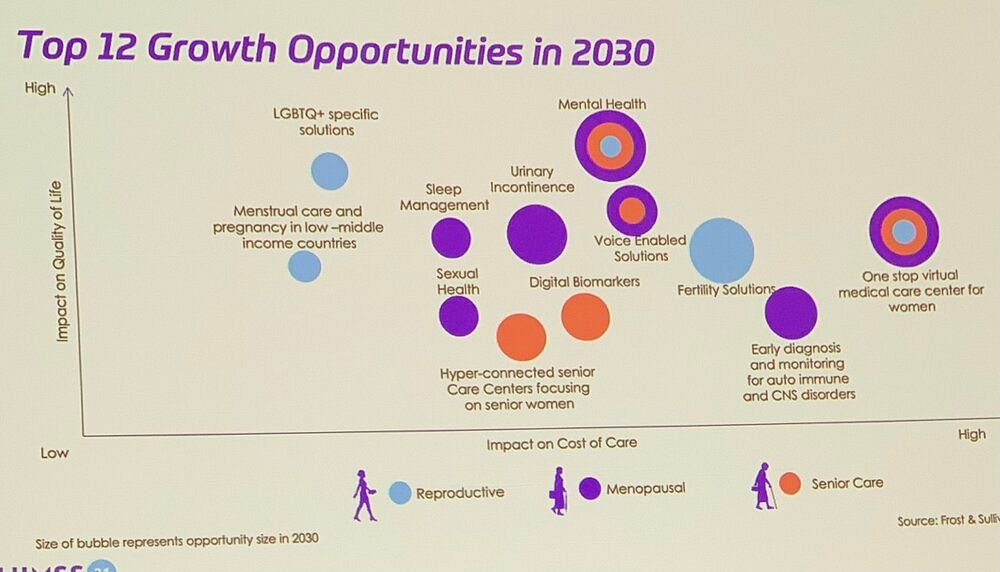
“With 50% of the global population as a target, the femtech industry’s potential is expected to cross $9 billion by 2021. Further, investments into femtech have been gaining strong traction. Femtech is the next big disruptor for the global healthcare market and it is important to not just identify growth opportunities, but also to formulate strategies that can make femtech more mainstream in the era of healthcare consumerism to alleviate the productivity and economic loss in the workplace due to women’s health issues, but also the loss to health systems.
The speakers in this session shared their views about the perspective of femtech, giving a 360-degree overview of the femtech market constitution and sharing how the femtech product and service innovations are going to transform the landscape for women’s health.”
Presented By:
-
Reenita Das - Partner and SVP Transformational Health, Frost and Sullivan
-
Chandni Mathur - Senior Industry Analyst, Frost and Sullivan
Below are some highlights from the presentation:
Women are Highly Marginalized Today
At Home:
-
Women spend 4.1 hours per day on domestic work, compared to 1.7 hours per day for men.
-
Women are 8X more likely to look after sick children/elderly, or manage children’s schedules than men.
At Work:
-
Working women spend 29% more per capita on healthcare as compared to men.
For Health:
Healthcare has been designed and developed by and for men
-
Women are underrepresented in clinical trials (1/3 of the trial population).
-
Men’s health issues, such as erectile dysfunction, get 5X the research grants as compared to women’s health issues like pre-menstrual syndrome (which has a 90% occurrence).
The Pandemic is Deepening Pre-existing Gaps, Exposing Vulnerabilities
At Home:
-
1 in 3 women have experienced physical/sexual violence.
-
Lockdown increased the burden of care on women.
At Work:
-
In 2020, women lost 64 million jobs, translating to $800 billion in earnings.
-
40-50% of senior level executives and mothers were burnt out at work.
For Health:
-
There could be 7 million unintended pregnancies — leading to maternal mortalities.
-
Over 70% of women reported clinically significant anxiety or depression.
Femtech Continues to be the Step-Child for Digital Health
The maximum funding for femtech was only 6.64% of the total Digital Healthcare funding for 2018, 4.51% in 2019, and a staggering 1.8% in 2020.
With Several Barriers to Realize its Full Potential
-
Lack of women as Venture Capitalists (VC) and accelerators.
-
Femtech apps are often created by men.
-
Pitching to male investors still remains a hurdle.
-
Societal taboos...

Femtech for fertility currently has the most solutions, but the research shows that women need an all-inclusive, sticky solution that can support them through their TOTAL life.

Most notable here, is the opportunities for tech for women in their menopausal and senior years.
However, in order for femtech to become mainstream, a lot of work needs to be done.
Strategic Imperatives for Success
-
Accessibility with respect to cost and outreach programs in developing countries would increase the customer base.
-
Driving adoption and adherence through government policies and insurance or reimbursement agencies.
-
B2B partnering with large public hospitals, healthcare companies, public health entities, and NGOs which have deeper distribution channels for mass screening and awareness campaigns.
-
Personalized revenue models based on the application of femtech solutions, like renting devices for limited period of use.
Future Strategic Directions
-
The future is in gender specific health and wellness
-
Healthcare is not a product. It is the sum of a woman’s genetics, way of life, our daily experiences and events. “Our zip code is the single largest predictor of health.”
-
Our definition of Healthcare needs to change. Health is more than the absence of disease. Focusing on diseases will not be profitable of sustainable long term to create healthy communities and countries.
-
The future lies in building communities around health—enlisting businesses, medical providers, government and nonprofits to work together.



